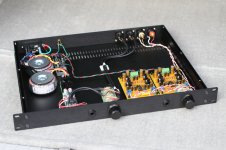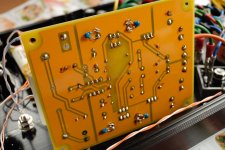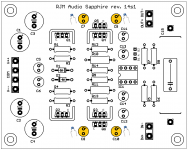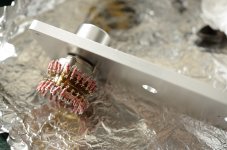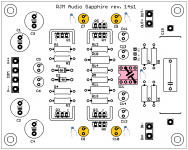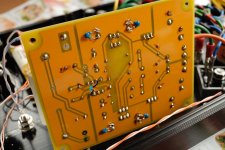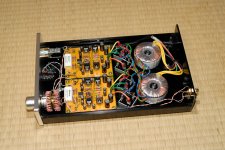Despite its rather old design the OP27 operational amplifier is still among the best choices for audio. It's particularly suitable for I/V stages and DAC buffers. This makes it suitable for almost any audio application, headphone amplifiers included. I encourage everyone to try it and hear it. Nowadays it is at affordable price and easy to obtain.
I agree, but I'm not sure it's ideal backing a 20 k or 50 k volume control. I'm open to the notion that a FET input configuration may be preferable here.
It was very interesting comparing the two, so much that I'm thinking I should try another pair, one FET and one bipolar, to see if the correlation holds. NE5534 for the bipolar, I think, and for the JFET type.... (?)
It was very interesting comparing the two, so much that I'm thinking I should try another pair, one FET and one bipolar, to see if the correlation holds. NE5534 for the bipolar, I think, and for the JFET type.... (?)
Hi Ray,
Go ahead and give them a try. No need to change any of the resistors. 0.47 uF goes against R6=100k to form the DC blocking input filter. 0.47 uF is the nominal minimum / sufficient value. Increasing the capacitance further doesn't impact on the audio frequency response significantly. Decreasing it below 0.47 uF starts to roll off the bass frequencies, but you could probably drop to 0.22 uF and not hear anything, while 0.1 uF might be used to deliberately compensate for "boomy" sounding headphones.
Go ahead and give them a try. No need to change any of the resistors. 0.47 uF goes against R6=100k to form the DC blocking input filter. 0.47 uF is the nominal minimum / sufficient value. Increasing the capacitance further doesn't impact on the audio frequency response significantly. Decreasing it below 0.47 uF starts to roll off the bass frequencies, but you could probably drop to 0.22 uF and not hear anything, while 0.1 uF might be used to deliberately compensate for "boomy" sounding headphones.
An update.
The Sapphire uses a non-inverting op amp topology; these can be tricky to get absolutely quiet: partly because the front end faces a volume control (high, variable output impedance) and partly because the noninverting input signal, which is the sensitive one that causes positive feedback if it couples to the output, sprawls over the case wiring, where it can easily get too close to the output wires or what not.
It's not too uncommon to run into trouble, even if you are pretty fastidious about shielding and proper dress.
My own build is quiet in most situations, but was acting up a little when attached to my home desktop PC - there's no earth connection, and cheap switching power supplies left, right and center.
Re that situation, the following observations:
Good interconnects help a lot.
The metal faceplate was in poor electrical contact with the main chassis, due to the paint acting as an insulator. Scratching off the paint in places to ensure a good contact helped.
Moving power bricks away from the interconnects helped.
If the PC was turned off, or the interconnects unplugged, the Sapphire was very quiet, just barely audible fussle when the volume control was maxed.
The big breakthough came, however, when I changed the chassis ground connection from the output headphone jack (OUT- -> chassis) to running individual ground wires from the chassis to IN- at the boards, instead.
I've tried the OPA27, NE5534 and OPA134 op amps. To me the OPA134 sounds the most melodic, but some people might prefer the drier, more neutral sounding NE5534. Didn't care for the OPA27 is this application.
Finally, I'm looking into a Zobel network for the output. Since the buffer is open loop there should not be any stability issues, but it can't hurt. Plan to try 10R/0.1uF and 47R/22nF. I've also tried adding 47 ohms in series with the headphone load, which should achieve much the same thing, and in addition linearizes the overall gain.
47 ohms in series was barely audible with my 300 ohm HD600s, perhaps a little less bright, a little more damped, a little cleaner. It was hard to tell. It worked well with my 16 ohm earbuds, the volume position was now similar to what I would use with the Sennheisers. No obvious lack of treble response despite the high output impedance.
I know that most people who have tried it seem to prefer not having the series resistance. Honestly to me it doesn't seem to be much, if any, loss in sound quality. However I will remove it and try the Zobel instead, see if that seems better.
The Sapphire uses a non-inverting op amp topology; these can be tricky to get absolutely quiet: partly because the front end faces a volume control (high, variable output impedance) and partly because the noninverting input signal, which is the sensitive one that causes positive feedback if it couples to the output, sprawls over the case wiring, where it can easily get too close to the output wires or what not.
It's not too uncommon to run into trouble, even if you are pretty fastidious about shielding and proper dress.
My own build is quiet in most situations, but was acting up a little when attached to my home desktop PC - there's no earth connection, and cheap switching power supplies left, right and center.
Re that situation, the following observations:
Good interconnects help a lot.
The metal faceplate was in poor electrical contact with the main chassis, due to the paint acting as an insulator. Scratching off the paint in places to ensure a good contact helped.
Moving power bricks away from the interconnects helped.
If the PC was turned off, or the interconnects unplugged, the Sapphire was very quiet, just barely audible fussle when the volume control was maxed.
The big breakthough came, however, when I changed the chassis ground connection from the output headphone jack (OUT- -> chassis) to running individual ground wires from the chassis to IN- at the boards, instead.
I've tried the OPA27, NE5534 and OPA134 op amps. To me the OPA134 sounds the most melodic, but some people might prefer the drier, more neutral sounding NE5534. Didn't care for the OPA27 is this application.
Finally, I'm looking into a Zobel network for the output. Since the buffer is open loop there should not be any stability issues, but it can't hurt. Plan to try 10R/0.1uF and 47R/22nF. I've also tried adding 47 ohms in series with the headphone load, which should achieve much the same thing, and in addition linearizes the overall gain.
47 ohms in series was barely audible with my 300 ohm HD600s, perhaps a little less bright, a little more damped, a little cleaner. It was hard to tell. It worked well with my 16 ohm earbuds, the volume position was now similar to what I would use with the Sennheisers. No obvious lack of treble response despite the high output impedance.
I know that most people who have tried it seem to prefer not having the series resistance. Honestly to me it doesn't seem to be much, if any, loss in sound quality. However I will remove it and try the Zobel instead, see if that seems better.
The Zobel report.
Took out the 47 ohm output series resistors, added instead 12 ohms + 0.1 uF (ceramic) Zobel filter. That just happened to be what I had, 3 - 5 times the resistance and 1/3 to 1/5th the capacitance would work just as well if not better.
Removing the 47 ohms I'd have to say that perhaps it did color the sound a little. With it, things were clean and clear, but somewhat dull. Without it, the impact factor as well as the surround factor increased noticeably. Some might say it's a bit splashy, but I like that.
Adding the Zobel didn't make any noticeable difference. I'll leave it in, because as things stand (OPA134, R14= 1ohm, zobel as above) it sounds as good as or better than it ever has. This is the combination that works for me.
(Headphones: Sennheiser HD600, Source: Onkyo SE-200PCI upsampling .wav CD data to 24/192, VLC media player, Win8 CP)
[Totally off topic aside: VLC audio playback sounds so much better than Windows Media Player, I wonder sometimes if there is some jiggery pokery going on behind the scenes...]
Took out the 47 ohm output series resistors, added instead 12 ohms + 0.1 uF (ceramic) Zobel filter. That just happened to be what I had, 3 - 5 times the resistance and 1/3 to 1/5th the capacitance would work just as well if not better.
Removing the 47 ohms I'd have to say that perhaps it did color the sound a little. With it, things were clean and clear, but somewhat dull. Without it, the impact factor as well as the surround factor increased noticeably. Some might say it's a bit splashy, but I like that.
Adding the Zobel didn't make any noticeable difference. I'll leave it in, because as things stand (OPA134, R14= 1ohm, zobel as above) it sounds as good as or better than it ever has. This is the combination that works for me.
(Headphones: Sennheiser HD600, Source: Onkyo SE-200PCI upsampling .wav CD data to 24/192, VLC media player, Win8 CP)
[Totally off topic aside: VLC audio playback sounds so much better than Windows Media Player, I wonder sometimes if there is some jiggery pokery going on behind the scenes...]
Last edited:
Yes, all you need to do is change the resistor values in the diamond buffer section to the ones listed in the B-board BOM. I can give you the details. You can leave off the heatsinks, they wont be needed.
The question lately occupying my mind is whether the circuit is sufficiently low noise.
My Sapphire amp, configured for headphones, has an input referred noise of 58 nV/sqrtHz. That's higher than the 8 nV/sqrtHz of the OPA134 op amp used in the input stage, so the diamond buffer is contributing to the output noise. Operating at reduced bias the output noise should be reduced, but even as-is it would be quiet enough as a high-quality pre-amplifier.
The question lately occupying my mind is whether the circuit is sufficiently low noise.
My Sapphire amp, configured for headphones, has an input referred noise of 58 nV/sqrtHz. That's higher than the 8 nV/sqrtHz of the OPA134 op amp used in the input stage, so the diamond buffer is contributing to the output noise. Operating at reduced bias the output noise should be reduced, but even as-is it would be quiet enough as a high-quality pre-amplifier.
Ceramic bypass capacitors
A significant improvement in sound quality can be obtained by bypassing the electrolytics near the diamond buffer with 0.1 uF ceramics. For more details, see my blog. It applies to both the B-board and Sapphire.
I will send caps to anyone who bought Sapphire (and B-board) boards/kits from me. Please contact me.
Not only does the top end become significantly less "edgy", but overall the background noise seems to be reduced. I had some trouble with RFI interference when I used my Sapphire with my desktop computer. That's gone now.
Why does it make such a difference? Well, I suppose the simple answer is that the diamond buffer has a bandwidth of 4 MHz or more, well in excess of the effective range of electrolytic capacitors. In principle there's no signal out there, but apparently it can pick up HF garbage which gets converted down to treble hash when not properly bypassed. I really not sure of the exact mechanics. I thought I would be safe by keeping the buffer out of the op amp feedback loop. Apparently I was wrong.
A significant improvement in sound quality can be obtained by bypassing the electrolytics near the diamond buffer with 0.1 uF ceramics. For more details, see my blog. It applies to both the B-board and Sapphire.
I will send caps to anyone who bought Sapphire (and B-board) boards/kits from me. Please contact me.
Not only does the top end become significantly less "edgy", but overall the background noise seems to be reduced. I had some trouble with RFI interference when I used my Sapphire with my desktop computer. That's gone now.
Why does it make such a difference? Well, I suppose the simple answer is that the diamond buffer has a bandwidth of 4 MHz or more, well in excess of the effective range of electrolytic capacitors. In principle there's no signal out there, but apparently it can pick up HF garbage which gets converted down to treble hash when not properly bypassed. I really not sure of the exact mechanics. I thought I would be safe by keeping the buffer out of the op amp feedback loop. Apparently I was wrong.
Attachments
Yesterday I replaced a small SMT-based 24 position attenuator with this Takman 24 position attenuator. Both from eBay. The trick was the faceplate was predrilled for 1/4" while the new attnuator was a 3/8" unit. The lock pin is also further off center.
Some creative work at the drill press and the new attenuator is properly fixed to the faceplate, as shown. It's a bit stiff : the small, smooth volume not means it's hard to to turn, but the sound is excellent. I was not impressed with the SMT unit, though since it was all of $5 I suppose I can't complain too loudly. Muffled and dull. This Takman stack, I'm in love with.
Some creative work at the drill press and the new attenuator is properly fixed to the faceplate, as shown. It's a bit stiff : the small, smooth volume not means it's hard to to turn, but the sound is excellent. I was not impressed with the SMT unit, though since it was all of $5 I suppose I can't complain too loudly. Muffled and dull. This Takman stack, I'm in love with.
Attachments
Hi RJM,
The only thing about my Sapphire I'm not happy with is the volume control. I think I used the same pot as you did and can't find the right volume level. Its never just right and too big a change between clicks. I had planned on putting a LDR pot I finally had working, but by the time I installed it, it stopped working and fitting a seperate power supply was difficult in my case.
I'm looking for a new pot and spotted the Takman on ebay just a few days ago.
I'd like to know how it goes and would be interested in any cheapish alternatives. Have considered and Alps RK27 20K on ebay.
Thanks for the cap suggestion. I'll see if I have any in the stash you sent me or try and get some locally at RS supplies.
Regards,
kffern
The only thing about my Sapphire I'm not happy with is the volume control. I think I used the same pot as you did and can't find the right volume level. Its never just right and too big a change between clicks. I had planned on putting a LDR pot I finally had working, but by the time I installed it, it stopped working and fitting a seperate power supply was difficult in my case.
I'm looking for a new pot and spotted the Takman on ebay just a few days ago.
I'd like to know how it goes and would be interested in any cheapish alternatives. Have considered and Alps RK27 20K on ebay.
Thanks for the cap suggestion. I'll see if I have any in the stash you sent me or try and get some locally at RS supplies.
Regards,
kffern
Hi Kevan,
I have a several hundred bypass caps on hand, please let me know if you need a set.
After some thought, listening, and general messing about, I realized it is a good idea to also bypass the op amp socket, as shown below. Otherwise the op amp ends up "bypassed" by the caps near the transistors, a poor arrangement that degrades the sound.
With the five bypass caps in place, OPA134>NE5534, though the NE5534 is perfectly fine.
As for the volume control, with the HLLY case I had to do some surgery to get it to fit, and the switch is too stiff to be comfortable with the small radius of the volume knob. For the actual level control, though, it's great. I'm typically listening at position 10-12 (gain 12x, HD-600s), at those settings its 2dB per step, more than fine-grained enough for my needs anyway.
I have a several hundred bypass caps on hand, please let me know if you need a set.
After some thought, listening, and general messing about, I realized it is a good idea to also bypass the op amp socket, as shown below. Otherwise the op amp ends up "bypassed" by the caps near the transistors, a poor arrangement that degrades the sound.
With the five bypass caps in place, OPA134>NE5534, though the NE5534 is perfectly fine.
As for the volume control, with the HLLY case I had to do some surgery to get it to fit, and the switch is too stiff to be comfortable with the small radius of the volume knob. For the actual level control, though, it's great. I'm typically listening at position 10-12 (gain 12x, HD-600s), at those settings its 2dB per step, more than fine-grained enough for my needs anyway.
Attachments
Last edited:
- Home
- Amplifiers
- Headphone Systems
- RJM Audio Sapphire Desktop Headphone Amplifier
